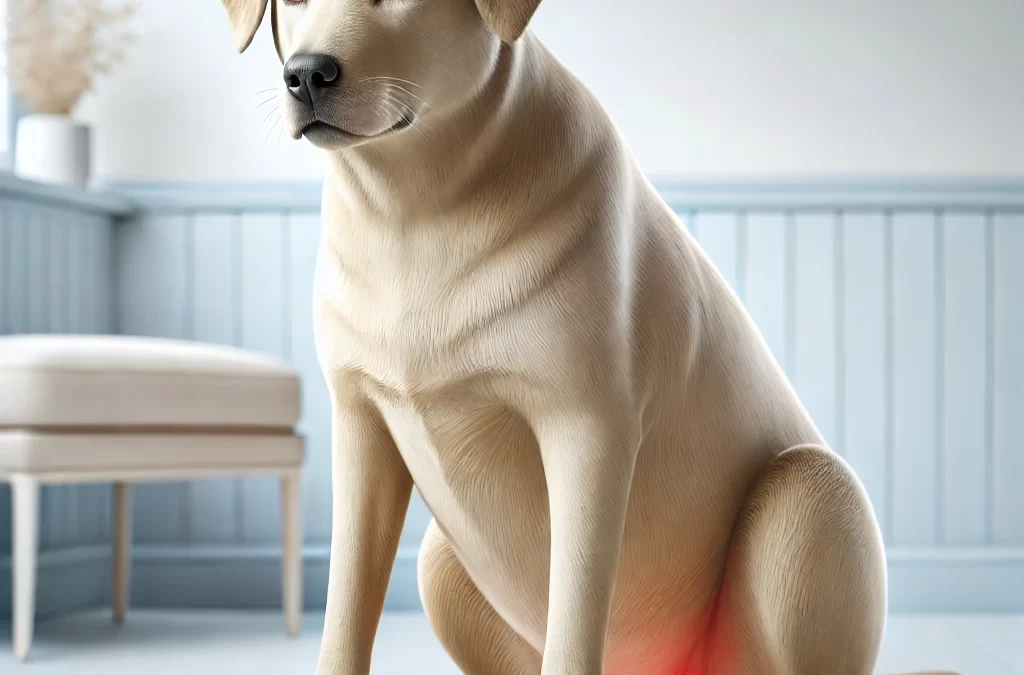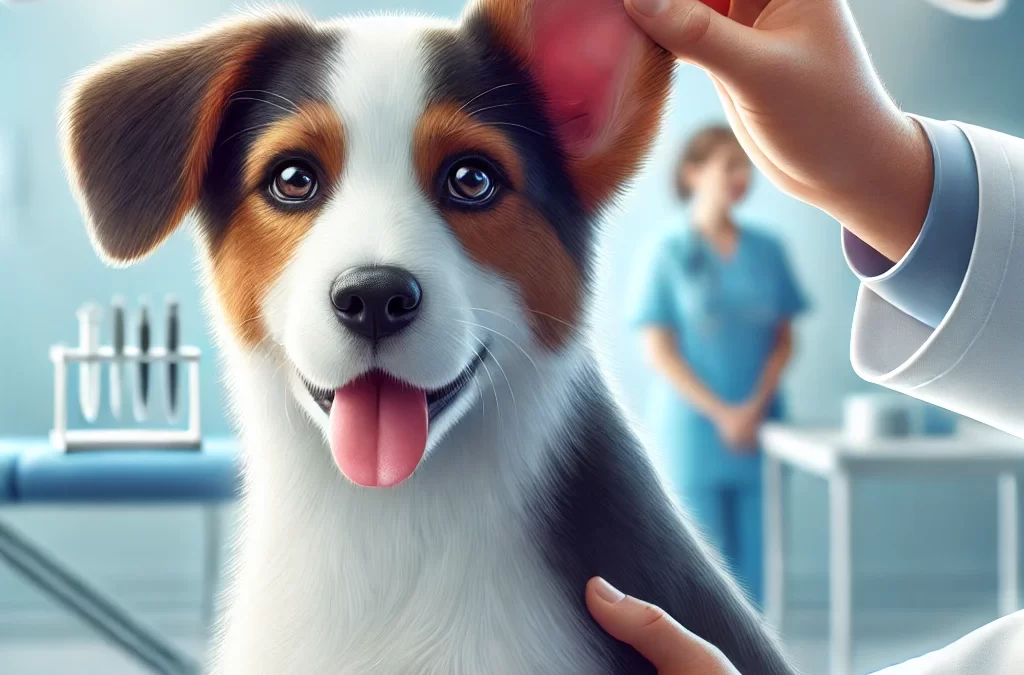
utworzone przez TCMVET | gru 14, 2024 | Rak i guzy u psów
Nieprawidłowe narośla w dolnych jelitach psów, choć nie tak powszechne jak inne problemy zdrowotne, są niepokojącym zjawiskiem, które często pozostaje niezauważone. Te narośla, które mogą wahać się od łagodnych polipów do złośliwych guzów, wpływają na trawienie psa, ogólny komfort i długoterminowe zdrowie. Zrozumienie ich przyczyn, objawów i opcji leczenia jest kluczowe dla zapewnienia lepszej jakości życia Twojemu futrzanemu towarzyszowi.
Czym są nieprawidłowe narośla w dolnym odcinku jelita?
Termin „nieprawidłowe narośla” obejmuje szereg stanów, które wpływają na dolny odcinek przewodu pokarmowego, w tym okrężnicę, odbytnicę i odbyt. Naroślami tymi mogą być:
- Polipy: Łagodne, niezłośliwe zmiany, które mogą powodować dyskomfort, ale rzadko się rozprzestrzeniają.
- Gruczolakoraki: Złośliwe nowotwory wywodzące się z komórek gruczołowych, często agresywne i inwazyjne.
- Mięśniakomięsaki gładkokomórkowe: Rzadkie, złośliwe nowotwory atakujące warstwę mięśni gładkich jelit.
- Chłoniaki: Rak tkanki limfatycznej jelit, powszechny u psów ze skłonnością do chorób przewodu pokarmowego.
Przyczyny powstawania guzów w dolnym odcinku jelita u psów
Dokładne przyczyny mogą być różne, ale na rozwój nieprawidłowych narośli wpływa kilka czynników:
- Age: Starsze psy są bardziej podatne na nowotwory jelit ze względu na starzenie się komórek i mutacje.
- Predyspozycje rasowe: U takich ras jak owczarki niemieckie i collie ryzyko wystąpienia nowotworów przewodu pokarmowego jest wyższe.
- Dieta i środowisko: Niska jakość diety, narażenie na toksyny lub przewlekłe podrażnienie jelit mogą prowadzić do nieprawidłowego wzrostu komórek.
- Przewlekły stan zapalny: Schorzenia takie jak zapalna choroba jelit (IBD) stanowią doskonałe środowisko do rozwoju nieprawidłowych narośli.
Znaki i objawy, na które należy zwrócić uwagę
Nieprawidłowe narośla w dolnych jelitach często dają subtelne lub niejednoznaczne objawy, co sprawia, że wczesne wykrycie jest wyzwaniem. Kluczowe objawy obejmują:
- Przewlekła biegunka: Uporczywe, luźne stolce, często z domieszką śluzu lub krwi.
- Zaparcia lub parcie: Trudności z oddawaniem stolca spowodowane blokadą wywołaną przez narośla.
- Krew w stolcu (hematochemia): Powszechnym wskaźnikiem jest jasnoczerwona lub ciemna, smolista krew.
- Ból brzucha: U psów mogą wystąpić takie objawy jak skomlenie, niepokój lub zgarbiona postawa.
- Weight Loss: Unexplained weight loss despite a normal appetite.
- Lethargy and Weakness: Spadek poziomu energii spowodowany anemią lub ogólnoustrojowymi skutkami wzrostu.
Diagnoza: Ujawnienie Ukrytego Problemu
Rozpoznanie rozrostów dolnego odcinka jelita wymaga połączenia badań klinicznych i zaawansowanej diagnostyki:
- Badanie lekarskie: Badanie odbytu może ujawnić wyczuwalne narośla w dolnym odcinku przewodu pokarmowego.
- Obrazowanie: Zdjęcia rentgenowskie, USG i tomografia komputerowa pozwalają na uwidocznienie guzów i określenie ich lokalizacji.
- Endoskopia: Kamera wprowadzona do jelita grubego umożliwia wykrycie i czasami wykonanie biopsji nieprawidłowej tkanki.
- Biopsja: Próbki tkanek potwierdzają, czy nowotwór jest łagodny czy złośliwy, co pozwala na zaplanowanie leczenia.
Opcje leczenia: dostosowane do każdego przypadku
Leczenie różni się w zależności od rodzaju, umiejscowienia i stadium wzrostu:
- Usunięcie chirurgiczne: Leczenie pierwszego rzutu w przypadku zmian miejscowych, zwłaszcza łagodnych polipów i małych guzów złośliwych.
- Chemioterapia: Zalecane w przypadku nowotworów, które dały przerzuty lub których nie można całkowicie usunąć chirurgicznie.
- Radioterapia: Stosowany w połączeniu z zabiegiem chirurgicznym w przypadku agresywnych nowotworów.
- Opieka paliatywna: Skupiamy się na leczeniu bólu i poprawie komfortu psa w zaawansowanych lub nieuleczalnych przypadkach.
Holistyczne wsparcie dla zdrowia układu pokarmowego
Chociaż leczenie medyczne ma na celu złagodzenie podstawowego schorzenia, dodatkowe wsparcie może zapewnić podejście holistyczne:
- Diety bogate w błonnik: Wspomaga trawienie i zmniejsza podrażnienia dolnych odcinków jelit.
- Probiotyki: Wzmacnia florę jelitową i wspiera ogólne zdrowie jelit.
- Kurkuma (Curcumin): Znany ze swoich właściwości przeciwzapalnych i potencjalnie przeciwnowotworowych.
- Olej CBD: Pomaga zmniejszyć stan zapalny i ból, poprawiając jakość życia psa.
Środki zapobiegawcze: zmniejszanie ryzyka
Choć nie wszystkim naroślom można zapobiec, możesz podjąć pewne kroki, aby zmniejszyć ryzyko wystąpienia u swojego psa:
- Regularne kontrole: Roczne badania weterynaryjne pozwalają wykryć nieprawidłowości na wczesnym etapie.
- Diety wysokiej jakości: Zapewnij zbilansowaną, odżywczą dietę, aby zminimalizować obciążenie układu pokarmowego.
- Monitoruj zdrowie stolca: Zwracaj uwagę na zmiany w nawykach wypróżnień i stolca Twojego psa.
- Ogranicz narażenie na toksyny: Unikaj karmienia psa karmą niskiej jakości i narażania go na działanie szkodliwych substancji chemicznych.
Emocjonalny wpływ na właścicieli zwierząt domowych
Opieka nad psem z naroślami jelitowymi może być wyczerpująca emocjonalnie. To naturalne, że czujesz się niespokojny lub przytłoczony, ale pamiętaj, że nie jesteś sam. Wiele źródeł, w tym grupy wsparcia i lekarze weterynarii, może poprowadzić Cię przez tę podróż.
Wniosek: Wiedza to potęga
Nieprawidłowe narośla w dolnych jelitach psów mogą wydawać się przerażające, ale dzięki wczesnemu wykryciu i proaktywnej opiece wiele psów może prowadzić satysfakcjonujące życie. Zachowaj czujność, regularnie zasięgaj porady weterynarza i zapewnij najlepszą możliwą opiekę swojemu czworonożnemu przyjacielowi.

utworzone przez TCMVET | gru 14, 2024 | Rak i guzy u psów
Jeśli chodzi o guzki na uchu psa, jedną z możliwości, która często zaskakuje właścicieli, jest histiocytoma. Te łagodne narośla są powszechne u młodszych psów i mogą wydawać się alarmujące ze względu na ich szybki rozwój i widoczne położenie. Jednak są one zazwyczaj nieszkodliwe i często ustępują samoistnie. Zanurzmy się w tym, co sprawia, że histiocytoma jest wyjątkowa i jak możesz zapewnić najlepszą opiekę swojemu futrzanemu przyjacielowi.
Czym jest histiocytoma?
Histiocytoma to niezłośliwy guz, który powstaje z Komórki Langerhansa, rodzaj komórek odpornościowych znajdujących się w skórze. Te guzy najczęściej występują u psów poniżej trzeciego roku życia i zazwyczaj występują na głowie, uszach lub kończynach.
W przypadku ucha histiocytomy często tworzą się na zewnętrznej powierzchni lub na krawędzi, tworząc widoczny guz, który może niepokoić właścicieli zwierząt. Pomimo dramatycznego wyglądu histiocytomy są uważane za jedną z najłagodniejszych form narośli u psów.
Dlaczego histiocytoma występuje u psów?
Dokładna przyczyna histiocytomy jest nieznana, ale uważa się, że jest ona związana z nadaktywną reakcją immunologiczną u młodszych psów. Rasy takie jak boksery, labradory i buldogi wydają się mieć większą predyspozycję, chociaż każda rasa może ją rozwinąć.
Jak rozpoznać histiocytomę w uchu
Guzy histiocytarne charakteryzują się charakterystycznym wyglądem i zachowaniem, dzięki czemu stosunkowo łatwo je wykryć:
- Wygląd: Podniesiona, okrągła, czerwona grudka, często bezwłosa i gładka. Na uchu może wyglądać szczególnie wyraźnie ze względu na cienką skórę i brak futra.
- Rozmiar: Zwykle małe, o średnicy około 0,5–2 cm.
- Tekstura: Twarda w dotyku, o lekko owrzodzonej lub błyszczącej powierzchni.
- Zachowanie: W przeciwieństwie do nowotworów złośliwych histiocytoma zazwyczaj nie powoduje dyskomfortu, chyba że zostanie zadrapana lub zakażona.
Czy powinieneś się martwić?
Jednym z najbardziej uspokajających aspektów histiocytomów jest to, że są samoograniczający się, co oznacza, że często znikają bez interwencji w ciągu 2 do 3 miesięcy. Jednak konsultacja weterynaryjna jest kluczowa, aby potwierdzić diagnozę i wykluczyć poważniejsze schorzenia, takie jak:
- Guzy komórek tucznych
- Rak kolczystokomórkowy
- Zakażenia ucha lub ropnie
Czego można się spodziewać podczas diagnozy
Lekarze weterynarii zazwyczaj stosują następujące metody w celu rozpoznania histiocytoma:
- Badanie lekarskie: Szczegółowe badanie guza i ogólnego stanu zdrowia psa.
- Aspiracja cienkoigłowa (FNA): Pobiera się niewielką próbkę komórek w celu przeprowadzenia analizy mikroskopowej.
- Biopsja: W rzadkich przypadkach w celu dalszego potwierdzenia może być wykonana biopsja.
Opcje leczenia i opieki
Większość nowotworów histiocytarnych goi się samoistnie, jednak w niektórych przypadkach może być konieczna interwencja:
- Leczenie nie jest wymagane: Jeśli guz nie przeszkadza psu, można go pozostawić w spokoju, aż zaniknie naturalnie.
- Usunięcie chirurgiczne: W rzadkich przypadkach, gdy narośl powoduje podrażnienie lub goi się powoli, lekarz weterynarii może zalecić jej usunięcie.
- Topical Treatments: Jeśli histiocytoma ulegnie owrzodzeniu, można zapobiec zakażeniu stosując kremy lub spraye z antybiotykiem.
Porady dotyczące pielęgnacji domu
Podczas oczekiwania na wyleczenie histiocytomy możesz podjąć następujące kroki, aby zapewnić psu komfort:
- Zapobiegaj zarysowaniom: Jeśli Twój pies nadmiernie drapie ucho, stosuj obrożę elżbietańską, gdyż może to doprowadzić do krwawienia lub infekcji.
- Monitoruj wzrost: Zwróć uwagę na rozmiar, kolor i fakturę guzka. Szybkie zmiany mogą wymagać wizyty kontrolnej.
- Wyczyść obszar: Delikatnie oczyść ucho roztworem zalecanym przez weterynarza, aby zmniejszyć ryzyko wtórnych infekcji.
Czym wyróżnia się histiocytoma ucha?
Histiocytomy w uchu mogą być bardziej widoczne ze względu na wrażliwą lokalizację ucha. Mogą powodować, że ucho wygląda asymetrycznie lub wiotko, a psy mogą częściej potrząsać głową. Te specyficzne objawy sprawiają, że monitorowanie i opieka są jeszcze ważniejsze.
Naturalne podejście do wspomagania procesu gojenia się psa
Niektórzy właściciele zwierząt domowych badają naturalne terapie, aby uzupełnić tradycyjną opiekę weterynaryjną. Chociaż te metody nie leczą, mogą wspierać ogólne zdrowie skóry:
- Kwasy tłuszczowe omega-3: Wspomaga zdrową odpowiedź immunologiczną i zmniejsza stan zapalny.
- Krem nagietkowy: Łagodzący ziołowy środek łagodzący podrażnienia wokół guzka.
- Olej CBD: Może pomóc zmniejszyć drapanie i stres związany z dyskomfortem.
Kiedy szukać porady weterynaryjnej
Mimo że histiocytoma jest łagodna, należy skonsultować się z lekarzem weterynarii, jeśli zauważysz:
- Guzek szybko rośnie lub zmienia swoją strukturę.
- Uporczywe drapanie, krwawienie lub wydzielina.
- Histiocytoma nie ulega regresji po 3 miesiącach.
Końcowe przemyślenia
Histiocytoma w uchu psa może wydawać się niepokojąca na pierwszy rzut oka, ale jest to zazwyczaj niegroźny stan, który ustępuje przy niewielkiej lub żadnej interwencji. Rozumiejąc jego wyjątkową naturę i zapewniając troskliwą opiekę, możesz zapewnić, że Twój pies pozostanie szczęśliwy i zdrowy przez cały proces.

utworzone przez TCMVET | gru 13, 2024 | Rak i guzy u psów
Rak nosa u psów, znany również jako rak nosa, jest stosunkowo rzadkim, ale agresywnym schorzeniem, które atakuje jamę nosową lub zatoki. Chociaż stanowi mniej niż 1% wszystkich nowotworów u psów, jego ciężkość wynika z inwazyjnego charakteru i trudności we wczesnym wykryciu. W tym artykule zagłębiamy się w objawy, diagnozę, opcje leczenia i opiekę wspomagającą dla psów walczących z rakiem nosa.
Czym jest rak nosa u psów?
Rak nosa u psów to przede wszystkim guzy rozwijające się w obrębie przewodów nosowych lub zatok. Najczęstszym typem jest gruczolakorak, ale mogą również wystąpić inne formy, takie jak rak płaskonabłonkowy, włókniakomięsak lub kostniakomięsak. Ten stan chorobowy zwykle dotyka starsze psy, przy czym większe rasy wydają się być narażone na nieco wyższe ryzyko.
Oznaki i objawy
Wczesne objawy raka nosa mogą być subtelne i często mylone z infekcjami dróg oddechowych lub alergiami. W miarę postępu choroby objawy stają się bardziej wyraźne. Zwróć uwagę na następujące rzeczy:
- Uporczywy wyciek z nosa
Charakterystycznym objawem jest jednostronna wydzielina (dotycząca jednego nozdrza), która ma charakter krwawy lub śluzowy.
- Częste kichanie
Przewlekłe kichanie, które nie ustępuje po leczeniu, może być objawem podrażnienia nosa przez guz.
- Obrzęk twarzy
Obrzęk wokół nosa, oczu lub czoła może wystąpić wskutek naciekania guza na otaczające struktury.
- Trudności z oddychaniem
Chrapanie lub głośny oddech mogą być objawem zatkania przewodów nosowych.
- Krwawienie z nosa (epistaksja)
Często zgłaszane są okresowe lub ciągłe krwawienia z nosa.
- Objawy neurologiczne
Jeśli guz rozprzestrzeni się do mózgu, mogą pojawić się takie objawy jak drgawki, dezorientacja lub zmiany w zachowaniu.
- Utrata apetytu i utrata wagi
Jak w przypadku wielu nowotworów, skutki ogólnoustrojowe mogą prowadzić do ograniczenia spożycia pokarmów i utraty wagi.
Diagnoza
Diagnostyka raka nosa wymaga dokładnej oceny, która obejmuje:
- Badanie fizykalne:Weterynarz może sprawdzić, czy twarz nie wykazuje asymetrii lub czy podczas oddychania nie słychać nieprawidłowych dźwięków.
- Rynoskopia:Mała kamera wprowadzona do przewodów nosowych umożliwia uwidocznienie guza.
- Obrazowanie:Zdjęcia rentgenowskie, tomografia komputerowa lub rezonans magnetyczny umożliwiają uzyskanie szczegółowych obrazów guza i jego rozprzestrzenienia.
- Biopsja:Próbki tkanek potwierdzają rodzaj i stopień zaawansowania raka.
Opcje leczenia
Leczenie zależy od wielkości, rodzaju i stadium guza, a także ogólnego stanu zdrowia psa. Opcje obejmują:
- Radioterapia
Radioterapia jest najskuteczniejszym leczeniem raka nosa, mającym na celu zmniejszenie guza i złagodzenie objawów. Chociaż może nie wyleczyć raka, może znacznie poprawić jakość życia.
- Chirurgia
Chirurgiczne usunięcie guza jest trudne ze względu na złożoną anatomię okolicy nosa, ale w niektórych przypadkach można się na nie zdecydować.
- Chemioterapia
Chemioterapia jest rzadziej stosowana, ale może być zalecana w przypadku niektórych typów nowotworów lub jako leczenie wspomagające.
- Opieka paliatywna
Gdy leczenie mające na celu całkowite wyleczenie nie jest możliwe, opieka paliatywna koncentruje się na łagodzeniu bólu i dyskomfortu za pomocą leków, w tym leków przeciwzapalnych, przeciwbólowych i obkurczających błonę śluzową nosa.
Terapie naturalne w opiece wspomagającej
Włączenie holistycznego podejścia do konwencjonalnych metod leczenia może poprawić komfort Twojego psa:
- Suplementy ziołowe
Zioła jak kurkuma (kurkumina) i traganek Uważa się, że mają właściwości przeciwzapalne i wzmacniające odporność.
- Dostosowanie diety
Wysokiej jakości dieta o niskiej zawartości węglowodanów korzystnie wpływa na ogólny stan zdrowia i zmniejsza stany zapalne.
- Olejek CBD
Kannabidiol może pomóc w łagodzeniu bólu i zmniejszaniu lęku u psów z zaawansowanym nowotworem.
Rokowanie i jakość życia
Rokowanie w przypadku raka nosa u psów zależy od czynników takich jak rodzaj guza i stadium zaawansowania w momencie diagnozy. Dzięki radioterapii wiele psów doświadcza ulgi w objawach i dłuższego czasu przeżycia, często od 8 do 18 miesięcy. Bez leczenia choroba postępuje szybko, często w ciągu kilku tygodni do kilku miesięcy.
Jak wspierać swojego psa
- Monitoruj objawy:Śledź zmiany w oddychaniu, jedzeniu i poziomie energii.
- Częste wizyty u weterynarza:Regularne kontrole zapewniają ścisłą kontrolę stanu zdrowia Twojego psa.
- Zapewnij komfort:Miękka ściółka, ciche otoczenie i łatwy dostęp do pożywienia i wody mają duże znaczenie.
Końcowe przemyślenia
Rak nosa u psów to trudna diagnoza, ale dzięki szybkiej interwencji i kompleksowemu planowi opieki możesz zapewnić swojemu psu najlepszą możliwą jakość życia. Zawsze konsultuj się z lekarzem weterynarii, aby poznać opcje leczenia dostosowane do konkretnych potrzeb Twojego psa.

utworzone przez TCMVET | gru 13, 2024 | Rak i guzy u psów
Rak nerki u psów, choć rzadki, jest poważnym schorzeniem, które może znacząco wpłynąć na jakość życia Twojego futrzanego przyjaciela. Wczesne rozpoznanie objawów może mieć duże znaczenie dla wyników leczenia. W tym artykule przyjrzymy się charakterystycznym objawom raka nerki, omówimy, dlaczego często pozostaje on niezauważony i przedstawimy informacje na temat opcji opieki wspomagającej.
Czym jest rak nerki u psów?
Rak nerki odnosi się do nieprawidłowego wzrostu komórek w jednej lub obu nerkach. U psów rak komórek nerkowych jest najczęstszym rodzajem raka nerki, dotykającym głównie starsze psy. Podczas gdy jego dokładna przyczyna pozostaje niejasna, predyspozycje genetyczne i narażenie na toksyny mogą odgrywać rolę.
Subtelne oznaki: dlaczego rak nerki często ukrywa się na widoku
Objawy raka nerki można łatwo pomylić z mniej poważnymi problemami, takimi jak infekcje dróg moczowych lub ogólne starzenie się. To nakładanie się objawów często opóźnia diagnozę. Oto, na co należy zwrócić uwagę:
- Częste oddawanie moczu lub trudności z oddawaniem moczu
Zwiększona częstotliwość oddawania moczu lub widoczny dyskomfort podczas oddawania moczu może wskazywać na obciążenie nerek lub niedrożność spowodowaną przez guz.
- Krew w moczu (krwiomocz)
Jasnoczerwony lub ciemnobrązowy mocz jest wyraźnym sygnałem ostrzegawczym, że z nerkami psa może dziać się coś złego.
- Utrata apetytu
Nagły brak zainteresowania jedzeniem w połączeniu z utratą wagi może być sygnałem problemów ogólnoustrojowych związanych z funkcjonowaniem nerek.
- Letarg
Jeśli Twój pies wydaje się niezwykle zmęczony lub niechętny do wykonywania codziennych czynności, może to wskazywać na ukryte zmęczenie spowodowane dysfunkcją nerek.
- Abdominal Swelling
Obrzęk brzucha może być wynikiem ucisku innych narządów przez duży guz nerki.
- Wymioty i nudności
W miarę postępu raka nerki we krwi gromadzą się toksyny, co powoduje problemy żołądkowo-jelitowe.
Czym rak nerki różni się od innych schorzeń
Wiele z powyższych objawów przypomina objawy choroby nerek, infekcji pęcherza moczowego, a nawet cukrzycy. Jednak w przypadku raka nerki objawy te są bardziej uporczywe i pogarszają się z czasem bez leczenia.
Rola diagnostyki
Wykrycie raka nerki wymaga przeprowadzenia następujących badań:
- Badania ultrasonograficzne i rentgenowskie umożliwiają obrazowanie potencjalnych guzów.
- Badania krwi ujawniają nieprawidłową pracę nerek lub anemię.
- Analiza moczu może pomóc w wykryciu mikroskopijnych komórek krwi lub komórek nowotworowych.
Lekarze weterynarii mogą również zalecić biopsję w celu potwierdzenia rodzaju i stopnia zaawansowania nowotworu.
Terapie naturalne w opiece wspomagającej
Choć często podstawowym sposobem leczenia jest chirurgiczne usunięcie chorej nerki, tradycyjne metody można uzupełniać holistycznymi metodami, aby poprawić jakość życia Twojego psa.
- Ziołowe środki zaradcze
Zioła takie jak Chuanxiong (lubczyk syczuański) mogą pomóc poprawić krążenie i zmniejszyć stan zapalny w okolicach nerek.
- Dostosowanie diety
Dieta o niskiej zawartości fosforu i wysokiej jakości białka wspomaga pracę nerek i odciąża drugą nerkę.
- Olejek CBD
Kannabidiol może pomóc w łagodzeniu bólu i redukcji stresu u psów poddawanych leczeniu.
Wskazówki dotyczące zapobiegania: czy można zmniejszyć ryzyko?
Choć nie da się całkowicie zapobiec rakowi nerki, istnieją kroki, które można podjąć, aby poprawić ogólne zdrowie nerek:
- Zapewnij świeżą, filtrowaną wodę.
- Unikaj narażenia na działanie znanych substancji rakotwórczych, np. pestycydów.
- Zaplanuj regularne kontrole weterynaryjne, zwłaszcza w przypadku starszych psów.
Kiedy udać się do lekarza weterynarii
Jeśli zauważysz którykolwiek z powyższych objawów, natychmiast skonsultuj się z lekarzem weterynarii. Wczesna interwencja może prowadzić do lepszych wyników, czy to poprzez operację, chemioterapię, czy opiekę paliatywną.
Końcowe przemyślenia
Rak nerki u psów to trudna diagnoza, ale proaktywne podejście do zdrowia psa może wiele zmienić. Rozpoznając subtelne zmiany i szukając terminowej porady lekarskiej, możesz zapewnić swojemu ukochanemu pupilowi opiekę i komfort, na jakie zasługuje.

utworzone przez TCMVET | gru 12, 2024 | Rak i guzy u psów
Rak odbytu u psów, choć stosunkowo rzadki, jest poważnym schorzeniem wymagającym natychmiastowej interwencji. Najczęściej diagnozowanym typem jest gruczolakorak woreczka odbytu, złośliwy nowotwór, który powstaje z gruczołów odbytu. Ten typ raka jest znany ze swojej agresywnej natury i potencjału rozprzestrzeniania się na inne części ciała. W tym artykule badamy objawy, diagnozę, opcje leczenia i rokowania dla psów dotkniętych rakiem odbytu.
Czym jest rak odbytu u psów?
Rak odbytu odnosi się do rozwoju złośliwych guzów w gruczołach odbytu lub w ich pobliżu. Te gruczoły, zlokalizowane po obu stronach odbytu, odgrywają rolę w wydzielaniu płynów używanych do oznaczania terytorium. Kiedy rak rozwija się w tych gruczołach, często rośnie szybko i może dawać przerzuty do pobliskich węzłów chłonnych, płuc lub innych narządów.
Objawy raka odbytu u psów
Objawy raka odbytu u psów mogą się różnić w zależności od wielkości i lokalizacji guza oraz tego, czy się rozprzestrzenił. Typowe objawy obejmują:
- Guzki lub obrzęki: Zauważalna masa lub obrzęk w okolicy odbytu.
- Trudności z defekacją: Parcie, ból lub zmiana kształtu stolca spowodowana obecnością guza blokującego odbytnicę.
- Krwawienie: Krew wokół odbytu lub w stolcu.
- Żucie lub lizanie: Psy mogą przesuwać się po podłożu lub nadmiernie lizać to miejsce z powodu dyskomfortu.
- Objawy hiperkalcemii: Zwiększone pragnienie, częste oddawanie moczu, letarg lub osłabienie spowodowane podwyższonym poziomem wapnia we krwi.
- Utrata wagi i utrata apetytu: W zaawansowanych przypadkach mogą wystąpić objawy ogólne, takie jak utrata masy ciała i zmniejszony apetyt.
Jak diagnozuje się raka odbytu?
Aby zdiagnozować raka odbytu, lekarze weterynarii stosują kombinację:
- Badanie lekarskie: Sprawdzenie, czy w okolicy odbytu nie ma guzków, obrzęków lub dyskomfortu.
- Biopsja aspiracyjna cienkoigłowa lub biopsja cienkoigłowa: Pobranie próbki tkanki guza w celu potwierdzenia złośliwości nowotworu.
- Badania krwi: Rozpoznawanie hiperkalcemii i innych nieprawidłowości.
- Obrazowanie: Zdjęcia rentgenowskie, USG lub tomografia komputerowa w celu określenia stopnia zaawansowania nowotworu i sprawdzenia, czy nie występują przerzuty.
Opcje leczenia raka odbytu u psów
Podejście do leczenia zależy od stadium i rozprzestrzenienia się nowotworu. Typowe opcje obejmują:
- Chirurgia: Podstawowym sposobem leczenia miejscowego raka odbytu jest chirurgiczne usunięcie guza i potencjalnie zajętych węzłów chłonnych.
- Radioterapia: Często stosuje się ją w połączeniu z zabiegiem chirurgicznym w celu zniszczenia pozostałych komórek nowotworowych.
- Chemioterapia: Zalecane w przypadku przerzutów nowotworu lub jako leczenie wspomagające inne metody leczenia.
- Opieka paliatywna: W zaawansowanych przypadkach leczenie bólu, modyfikacja diety i leczenie wspomagające mogą poprawić jakość życia.
Rokowanie dla psów z rakiem odbytu
Rokowanie u psów z rakiem odbytu zależy od kilku czynników, w tym wielkości guza, jego rozprzestrzenienia i zastosowanego leczenia. Wczesne wykrycie i agresywne leczenie poprawiają wskaźniki przeżywalności, a wiele psów doświadcza dłuższych okresów dobrej jakości życia po leczeniu. Jednak zaawansowane przypadki z przerzutami mają mniej korzystne rokowanie.
Opieka nad psem z rakiem odbytu
Jako właściciel zwierzęcia domowego, zapewnienie psu przyjaznego i komfortowego środowiska jest niezbędne. Postępuj zgodnie z tymi wskazówkami:
- Regularne wizyty u weterynarza: Zaplanuj regularne kontrole, aby monitorować stan zdrowia swojego psa.
- Nutrition: W trakcie leczenia zapewnij psu zbilansowaną dietę dostosowaną do jego potrzeb.
- Leczenie bólu: Współpracuj z lekarzem weterynarii, aby zapewnić psu komfort.
- Wsparcie emocjonalne: Zapewnij psu miłość i poczucie bezpieczeństwa, aby pomóc mu poradzić sobie ze stresem związanym z leczeniem.
Wnioski
Chociaż rak odbytu u psów jest agresywny, wczesne wykrycie i kompleksowy plan leczenia mogą znacząco wpłynąć na wyniki. Zachowaj czujność w kwestii objawów i niezwłocznie zwróć się o pomoc weterynaryjną, jeśli zauważysz jakiekolwiek nietypowe oznaki. Przy odpowiednim wsparciu i opiece Twój pies może utrzymać dobrą jakość życia, nawet w trudnych czasach.





